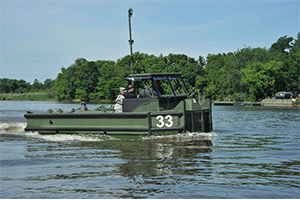To Cross Is To Conquer
Michael S. Reedy
Test Officer, Force Projection and Watercraft Branch, Warfighter Directorate

A BEB crosses the Spesutie Narrows.
In wartime, bridge destruction by the enemy must be overcome.
ATC’s testing brings the Bridge Erection Boat (BEB) close to full-rate production.
Wet-gap bridging, the crossing of a body of water with vehicles or personnel, is not a high-profile commodity in the military community. However, its importance is not lost on Product Manager Bridging, the division of U.S. Army TACOM Life Cycle Management Command responsible for acquiring the hardware to obtain this capability. The motto of Product Manager Bridging, “To Cross Is To Conquer,” communicates the vital need for Soldiers to physically travel where needed during conflict. In December 2015, the Iraqi Army used BEBs and improved ribbon bridges from the U.S. Marine Corps to span the Euphrates River and take back Ramadi from the Islamic State, which had destroyed the other three bridges leading into the city.
The XM 30 BEB is used primarily to push bridge bays in support of worldwide floating bridge and rafting operations of the Multirole Bridge Company (MRBC). The boats provide high thrust at low speeds and operate in environments with high particulate matter (e.g., sand in the air; mud and salt in water). The BEB’s wide front face and high deck provide excellent stability during operation, with raised walking areas front and rear for safe movement between bridge bays. The previous version of the BEB, the Mk II, is still the primary BEB used by the military; however, the Mk II is more than 30 years old, some of its parts are obsolete, and it cannot run with jet fuel. The Army needs a boat with a newer fly-by-wire (electronic) control system compatible with jet fuel. Additional thrust is also required for increasingly heavier Army equipment and ballistic crew protection. The XM 30 BEB is a pristine example of the Army’s incremental modernization efforts.
The XM 30 BEB had unique design requirements; perhaps the most paramount consideration was the need for it to interface with previously fielded Army inventory being used by the MRBC, including bridges, transportation pallets and transport trucks. Direct interface between the BEB, pallet and truck for transport and launch/retrieval means the Army can retire the obsolete boat cradles required for the legacy BEBs. This will decrease the logistics footprint and maintenance burden on Soldiers and will prove invaluable to military personnel and taxpayers.
The XM 30 is nearing the end of its testing at ATC. In early 2015, seven low-rate initial production BEBs were received for developmental testing, which included human factors engineering, high and low temperature storage and operation, reliability and maintainability, ballistic survivability, transportability and performance. In the critical military load class 140 rafting operation, two BEBs propelled a seven-bay ferry loaded with two 70-ton M1 Abrams tanks. The test was done to ensure BEBs can provide maneuverability and thrust for vehicle transport by ferry. In addition, helicopter sling loading was done to test the capability of the BEB to be dropped into water if no launch ramp is available or if the boat needs emergency placement on the water.
Reliability testing on five BEBs replicating a typical mission of bridge crew members was done in Spesutie Narrows, an extremely harsh environment. This muddy body of water is shallow and partially salty, and its temperature fluctuates from 80oF in summer to below freezing in winter. Spesutie Narrows is one of the test areas that makes ATC the ATEC Test Center Workload Assignment 10-series primary test facility for bridging and watercraft.
After production qualification testing will come a logistics demonstration and limited user test performed by active-duty Soldiers. The test program will help the military make decisions about full-rate production and full materiel release of the BEB, as the Army plans to acquire 375 BEBs. Soon, the MRBC will have an upgraded, state-of-the-art BEB to cross any wet gap encountered.
You are now leaving www.atc.army.mil and entering another site. You will automatically be forwarded to the target page within five seconds.
